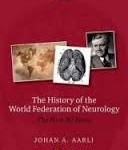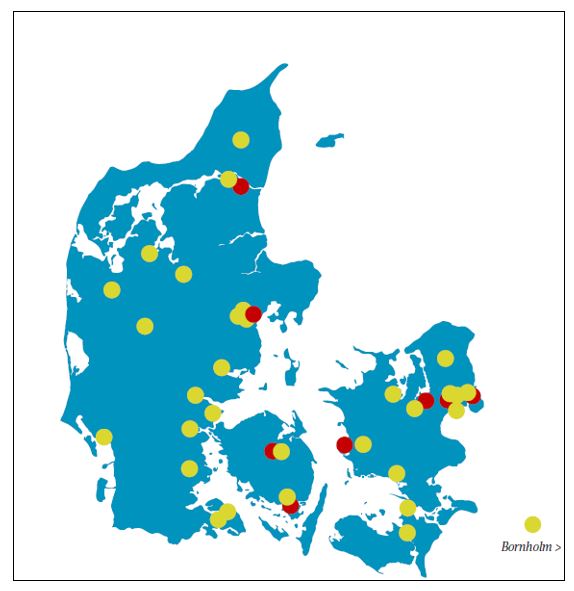Review of The History of the World Federation of Neurology: the first 50 years by Johan A Aarli. Oxford University Press, 2014
by François Boller
 This book reviews the history of the first 50 years of the WFN which was officially founded in 1957. One question immediately comes to mind: why 1957? There may be a debate about the “date of birth” of neurology, but everybody agrees that it was firmly established as a discipline by the first part of the twentieth century or even before that time. In subsequent years there were several meetings attended by international members, even though the two World Wars forced the cancellation of some of these meetings. Why then did we have to wait until 1957 to see the foundation of WFN? One probable reason is that international collaboration, like international travel, was much less common than it later became. It took the strength and charisma of one man, Ludo van Bogaert, to carry through the creation of the Federation. Note that in its early years, WFN was “worldly” only in name: Asia, Africa and Oceania were barely represented. Yet it was certainly quite international. A picture in the first pages of the book shows that of 10 delegates participating in an early WFN organisational meeting, one was from Cuba, one from Iran while a third was a neurosurgeon representing India. Iran and India were the only two Asian countries present in the initial years of WFN. In its first years, WFN survived mainly thanks to a grant from the US-based National Institutes of Health (NIH).
This book reviews the history of the first 50 years of the WFN which was officially founded in 1957. One question immediately comes to mind: why 1957? There may be a debate about the “date of birth” of neurology, but everybody agrees that it was firmly established as a discipline by the first part of the twentieth century or even before that time. In subsequent years there were several meetings attended by international members, even though the two World Wars forced the cancellation of some of these meetings. Why then did we have to wait until 1957 to see the foundation of WFN? One probable reason is that international collaboration, like international travel, was much less common than it later became. It took the strength and charisma of one man, Ludo van Bogaert, to carry through the creation of the Federation. Note that in its early years, WFN was “worldly” only in name: Asia, Africa and Oceania were barely represented. Yet it was certainly quite international. A picture in the first pages of the book shows that of 10 delegates participating in an early WFN organisational meeting, one was from Cuba, one from Iran while a third was a neurosurgeon representing India. Iran and India were the only two Asian countries present in the initial years of WFN. In its first years, WFN survived mainly thanks to a grant from the US-based National Institutes of Health (NIH).
In this nicely presented volume, Dr Aarli, who has actively participated in the activities of WFN for many years, including a term as President, describes the state of neurology before 1957 and narrates how WFN took shape, evolving gradually into today’s structure and organisation. He then describes in varying amounts of detail the organisation of the Research Committee and the Research Groups, at first called “Problem Commissions”. Subsequent pages of the volume provide details about the regional neurological associations and the relationship with the World Health Organization. The volume continues with a chapter which further illustrates the close ties of neurology with world events. The Indian neurologist Noshir Wadia went to jail and Jun Kimura (Kyoto, Japan) almost went to jail. Both were absolutely innocent: Wadia had been kidnapped and jailed by the police of the Portuguese dictator Salazar in retribution of India having annexed the tiny enclave of Goa; and the charges of embezzlement brought against Kimura were completely unjustified. Both Wadia and Kimura played important roles in developing neurology and neuroscience in their respective country and within the WFN. The book concludes with a review of the International Congresses that took place since 1957, first every 4 years and now every two years. A short but exciting epilogue is written by Vladimir Hachinski who, as President until 2013, perfectly embodied the motto Continuity and Change. This epilogue provides an interesting view into the future of WFN now under the helm of Raad Shakir.
One of the interesting features of Dr Aarli’s narrative is the glimpses it provides into the features and developments of the world at large during those years. It reminds us of how much things have changed in this relatively short space of less than 60 years. For instance we hear about the relations between the German Neurological Societies when a wall divided the Federal Republic and its Eastern counterpart, the German Democratic Republic. The relations ranged from non-existent to acrimonious. We witness the very gradual entry of African countries into the WFN as they became independent in the early 60’s. In one of the most thrilling parts of the book, we read about the “slow boat to China”. Dr Aarli built on the efforts of his predecessors, John Walton and Jun Kimura, and managed a diplomatic exploit. That is certainly what it took to reach the point where delegates from the People’s Republic of China, the Hong Kong Neurological Society and the Taiwanese Neurological Society agreed to sit together. A picture showing the Presidents of the three Societies posing next to Dr Aarli illustrates that truly historic moment.
Dr Aarli reminds us that decentralisation was always a theme of WFN, but different players interpreted the concept differently. On one hand, decentralisation could provide a more equitable division of labour among the WFN members and thus Ludo van Bogaert and Pearce Bailey vigorously advocated it from the beginning. Others such as Hans Hoff from Austria and Russell DeJong from the USA feared that it could lead to fragmentation of the Federation. Regional societies now exist, but they have evolved in different fashions. The Asian Oceanian Association (AOAN) has attracted countries such as Mongolia and Myanmar to join both AOAN and WFN, but we are not told much about the Congresses of AOAN which are held every two years. Similarly not much is said about the Pan Arab Union of Neurological Societies (PAUNS) which had its first meeting in Cairo in 1975. Recent PAUNS meetings have taken place in Damascus in 2010 and in Sharm el-Sheikh in 2013. In Europe on the other hand, the regional society has developed considerably. The earliest European association known initially as Pan European included mostly neurologists from what was known as Eastern Europe and it did not have much prestige until it evolved into the European Federation of Neurological Societies (EFNS) in 1991. The other European scientific society, the European Neurological Society (ENS) was created in 1986 and its first meeting organised by Gérard Saïd (Kremlin-Bicêtre) and Pierre Rondot (Sainte-Anne) took place in Nice in 1988 with PK Thomas as first President. ENS was modelled on the American Neurological Association (ANA) and conceived as a body of scientists elected because of their merit and not their nationality. The two societies have merged in the spring of 2014 into the European Academy of Neurology (EAN). It is presided by Günther Deuschl and will have its first meeting in Berlin in 2015. This process is in great part due to the determination of the Presidents (particularly Franz Gerstenbrand, Jes Olesen, Jacques De Reuck and Richard Hughes for EFNS and Gustave Moonen, José Ferro and Claudio Bassetti for ENS) and also to the creation of the Journal, the European Journal of Neurology (François Boller and Per Soelberg Sörensen, Founding Editors; Anthony Shapira current Editor) which will be the official organ of the EAN. Under the auspices of Gustavo Roman and others, an effort is under way to develop an American Federation of Neurological Societies.
As can be expected, the development of WFN was far from being always smooth. Dr Aarli displays the full extent of his elegant diplomacy when he discusses some of the rougher moments of the WFN: “conflicts”, “problems” and “the usual suspects” are alluded to in ways that will be well understood by WFN insiders. He refers to a real or narrowly avoided catastrophe as “an unforeseen event”. And all the players are hardworking, true leaders full of ideals and integrity. Of course this is true in most cases. However it is amusing to read the descriptions of some of the same people given elsewhere, for instance the admirable and highly readable book “A fragmented memoir: life and the teeming brain” Bacchante Books, 2013, by John Moossy. Moossy, a neurologist and neuropathologist, former Editor-in-Chief of the Journal of Neuropathology and Experimental Neurology, lived through many of these events including a one year stay at van Bogaert’ Bunge Institute. Moossy freely distributes high praises to some such as van Bogaert himself and the late Charles Poser, also a very important player in the creation and evolution of WFN. On the other hand he does not hesitate to use much sharper words for people who played a dominant role in the development of WFN, but who he did not like as much. It is not clear whether Giancarlo Guazzi, an important collaborator of van Bogaert from 1958 to 1968, played any role in the early years of the WFN. Actually Guazzi is not mentioned in the book, but he is indirectly alluded to when we are told that van Bogaert received a Honoris Causa Doctorate in Siena (unfortunately misspelled), Guazzi’s Alma Mater.
In conclusion, this book is a great tribute to a great organisation. This reviewer fully shares the words of Lord Walton who writes in his preface: Posterity will be very grateful to Professor Aarli for this historical work of scholarship.




